
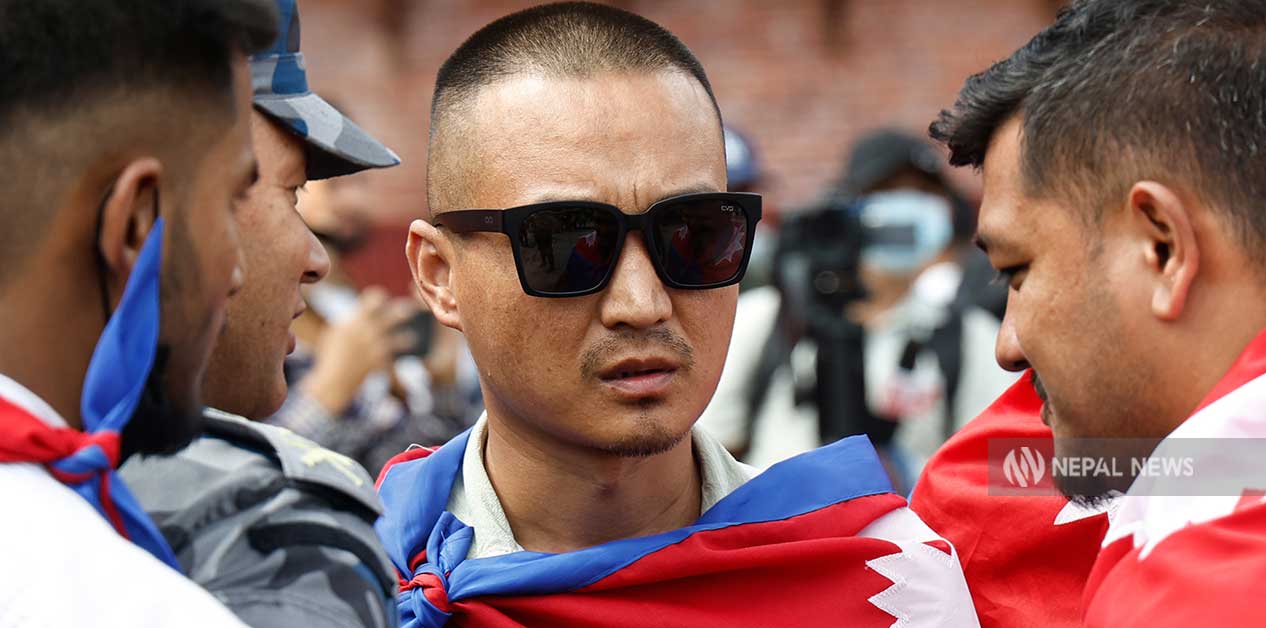
People of Dharan and stakeholders sometimes protest against the mismanagement at B.P. Koirala Institute of Health Sciences, and sometimes doctors and staff within the institute stage demonstrations claiming inadequate services and facilities. This process has been going on for a long time.
In mid-2021, however, a group with no direct apparent connection to the Institute suddenly arrived in Dharan from Kathmandu, claiming to protest ‘against the extreme mismanagement and anomalies of the Institute.’
The team from the organization ‘Hami Nepal’, whose address is Kathmandu, arrived in Dharan to protest in a white Nissan company vehicle. The leader of the team was Sudan Gurung, the organization’s president, who is currently in the spotlight following the Gen Z movement.
They conducted the movement in Dharan while staying in a hotel for about five months.
Even after the movements by local residents, doctors, and staff of the B.P. Institute in Dharan had concluded, the government had formed an investigation committee, and the report had been made public, the question of why a social organization from Kathmandu came to Dharan to conduct such an expensive movement has been a topic of discussion from that time until now. This is because the sequence of events at that time was somewhat unusual.
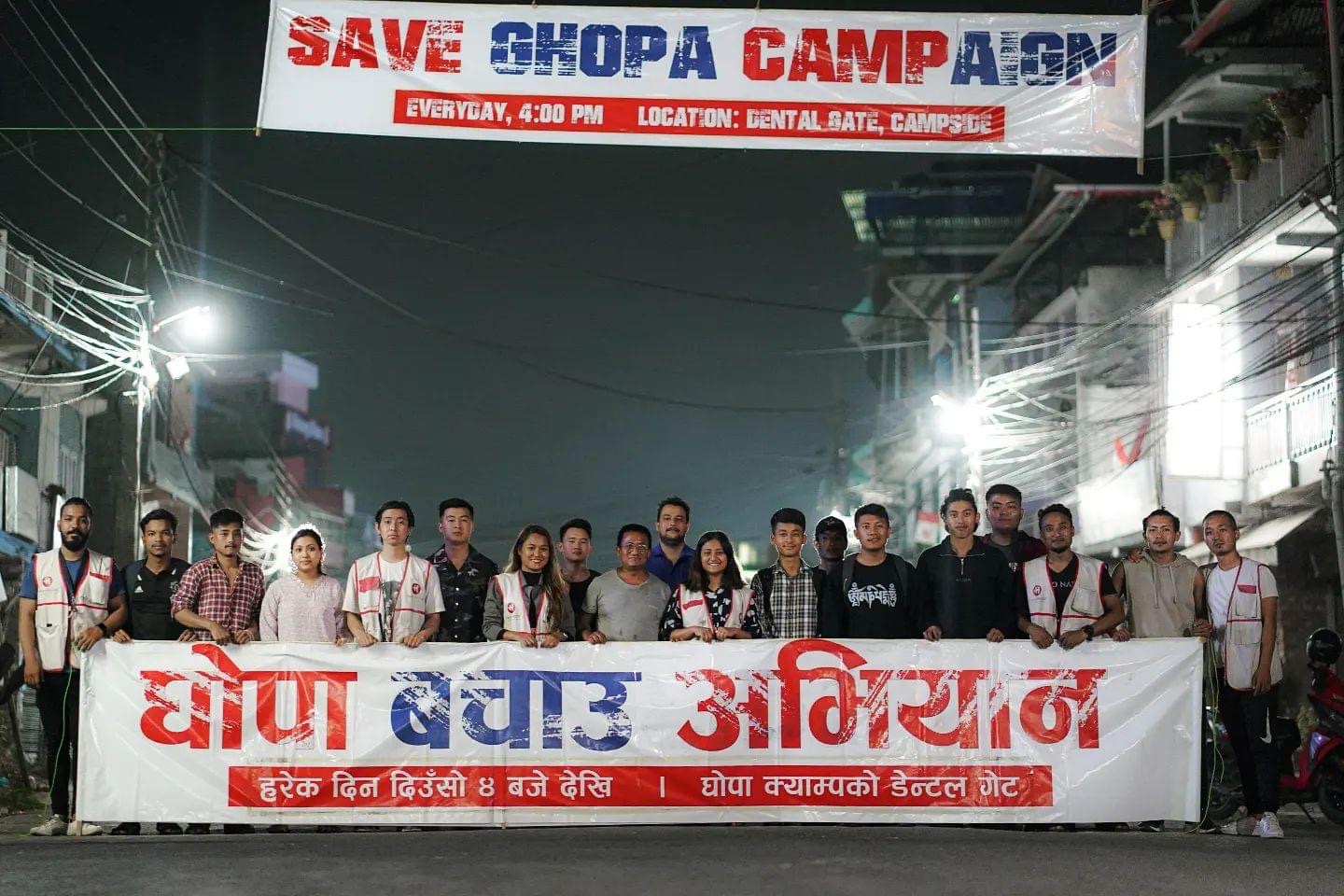
Ghopa Bachau Abhiyan (Save Ghopa Campaign) held in Dharan. Photo: Hami Nepal
On April 8, 2020, Dr. Gyanendra Giri was appointed Vice-Chancellor of the Institute by then-Prime Minister K.P. Sharma Oli upon the recommendation of the then-Minister of Health and Population, Bhanubhakta Dhakal. However, immediately following his appointment, Giri faced controversy, and doctors and staff protested against him repeatedly.
In 2021 also, doctors and staff of the Institute staged protests that affected both hospital services and education. During that protest, the resignation of the Institute’s Vice-Chancellor, Giri, was demanded. Giri used to prefix ‘Professor’ to his name, but after it was found that he had not been granted the Professor position from any source, his resignation was sought on the grounds of forgery.
Sudan’s team, which arrived with the slogan of ending the overall mismanagement of the Institute, received open support from the youth and social organizations of Dharan. Following this, the ‘Ghopa Bachau Abhiyan’ (Save Ghopa Campaign) was launched, comprising representatives of ‘Hami Nepal’ and local organizations.
The government formed a committee to identify and investigate the problems of the Institute. The doctors’ and staff’s movement subsided after the court ordered against staging protests in a sensitive area like a hospital.
Just a few months after the internal movement within the Institute had cooled down, Sudan’s team arrived from Kathmandu and started a protest outside the Institute’s gate. ‘Hami Nepal’ started the movement from Bhanu Chowk in Dharan on April 2, 2022. After that, a daily sit-in program was held in front of the gate of the B.P. Institute’s Dental Department.
When the team from Kathmandu suddenly started the movement, some people accused them of being mobilized by someone from within the Institute, while others suggested they were sent by leaders and businessmen from above.
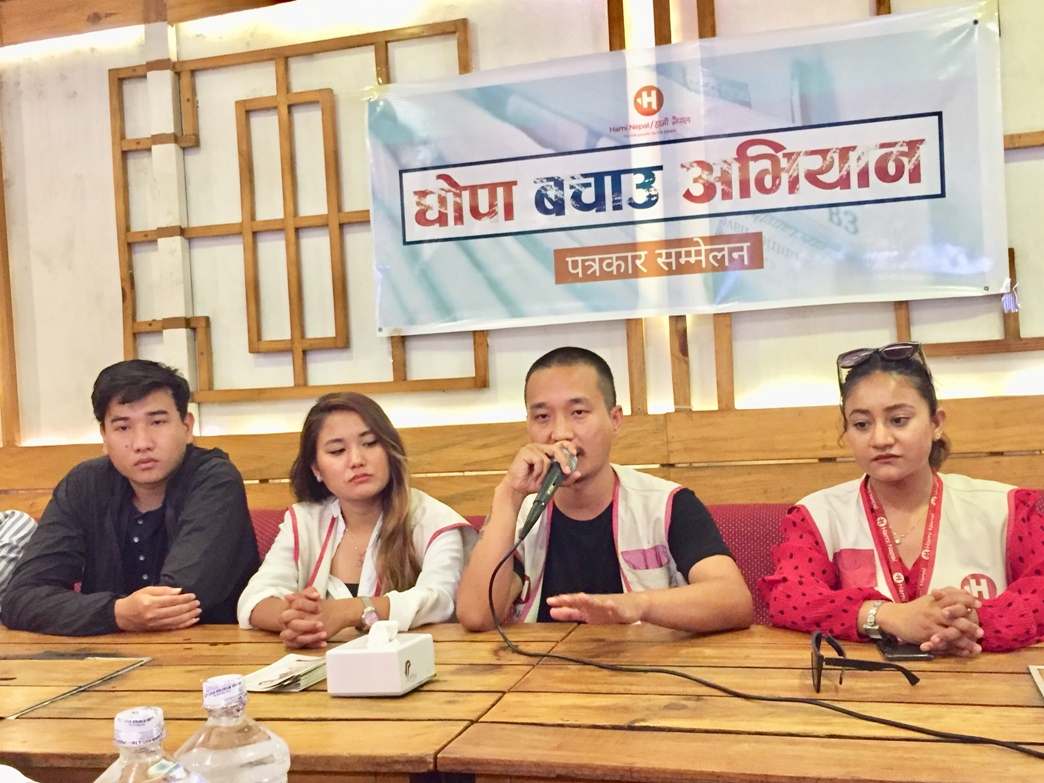
Press conference of the Ghopa Bachau Abhiyan. Photo: Gopal Dahal/Nepal News
As the movement progressed, such suspicions about Sudan’s team emerged not only from outside but also from within the protesting team. The objective and demands of the movement, which started with the aim of ending the mismanagement of the Institute, began to change midway. Dissatisfaction grew within the group, as coordinator Sudan was accused of making unilateral decisions without group discussion. Mahesh Shrestha, President of the Newar Unity Society, who had participated in the movement led by Sudan from the beginning, left their side within a few weeks. Shrestha says, “Initially, we supported it because the slogan was to remove B.P.’s mismanagement, but midway, Sudan started raising various demands with the Institute management without consulting anyone in the team. When we suggested moving forward by discussing as a team, he would say it came from the core group above. After that, we realized this movement was being mobilized from somewhere else and left their side.”
According to those who participated in the movement at that time, Sudan had access to the then-Prime Minister and Nepali Congress President Sher Bahadur Deuba and leader Gagan Thapa even then. He was also in contact with the then-Health Minister Birodh Khatiwada. Mahesh Shrestha, President of the Newar Unity Society, says, “Sudan would occasionally talk about meeting Deuba and Gagan. He would tell us that talks were ongoing with the Minister about the movement.”
Just as Sudan is vague about how to proceed after the Gen Z movement, he was similar in the Dharan movement. He would change the issues from time to time. When he started the movement in Dharan, his demand was to end the mismanagement of the B.P. Institute, but by the time the movement concluded, he compromised on simple issues such as the need to tender for the purchase of an MRI machine.
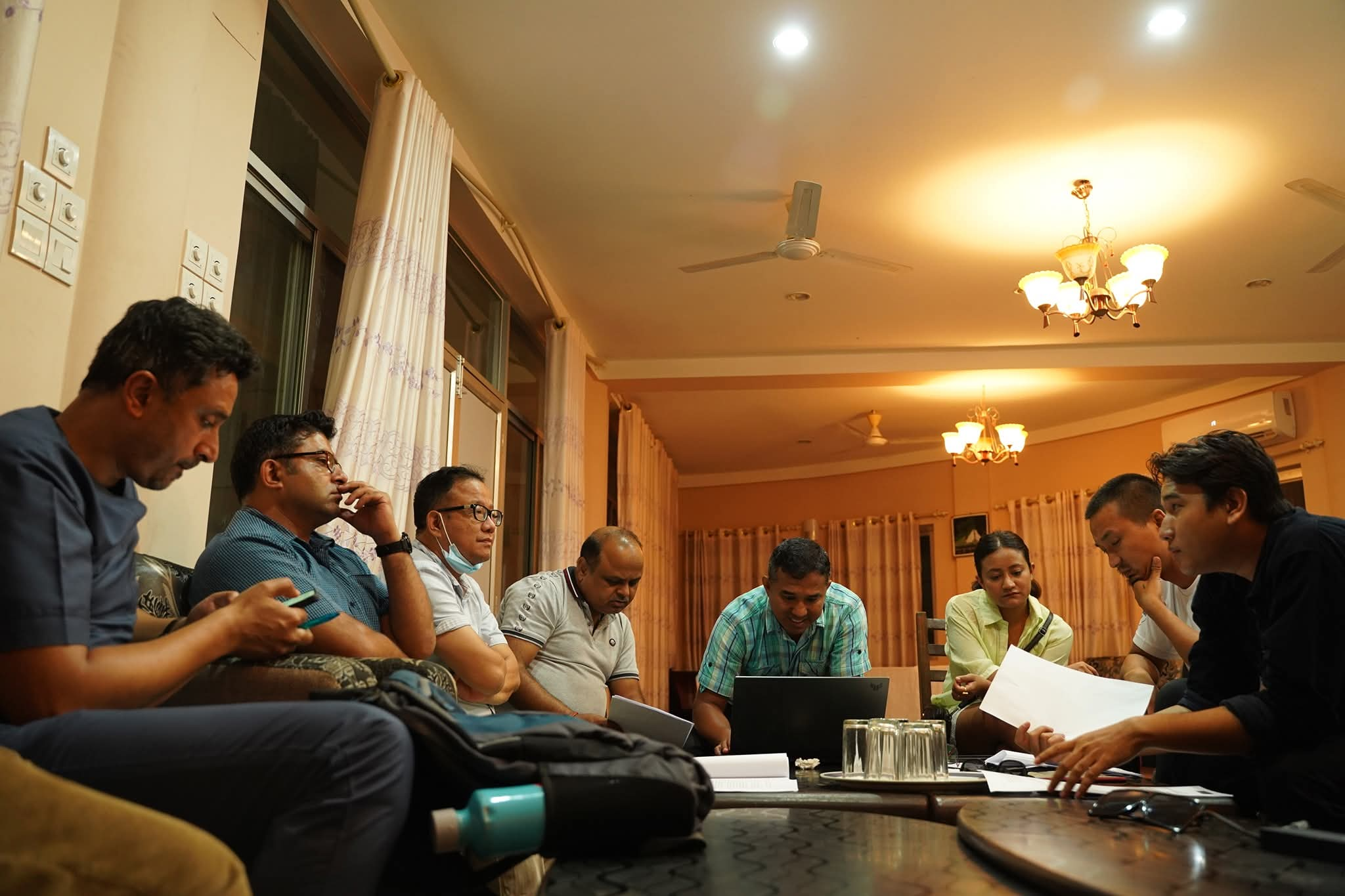
Talk between the Institute team and the protesters. Photo: Hami Nepal
Devlal Shrestha of Dharan, who participated in the Ghopa Bachau Abhiyan from beginning to end, says, “We also joined because they came from far away to protest. But the change we expected did not happen. Although there were minor improvements, the main problems remain the same even now.”
Sudan’s team started the movement by issuing a press statement on April 2, 2022, stating that they would continue peaceful demonstrations until the Institute’s mismanagement ended. At that time, ‘Hami Nepal’ put forward a seven-point demand, including that appointments in the Institute must be made according to standards, corrupt and irresponsible employees should be punished, the process for purchasing essential machines like MRI should be advanced, transparency should be maintained in the hospital, treatment procedures and medicine procurement should be organized, and hospital waste management should be done according to the standards of the World Health Organization.
Sudan’s team, which arrived with the slogan of ending the overall mismanagement of the Institute, received open support from the youth and social organizations of Dharan. Following this, the ‘Ghopa Bachau Abhiyan’ was launched, comprising representatives of ‘Hami Nepal’ and local organizations. Under the campaign, protesters started staging sit-ins on the B.P. Institute premises.
At that time, the local level election of 2022 was approaching. Harka Sampang, currently the Mayor of Dharan, had already started his election campaign. He went to the protest site, declared his support for B.P. Institute reform, and asked for votes, promising to improve the Institute if he won. The then-Mayor of Dharan, Tilak Rai, also visited the protest site and delivered a speech stating that everyone should work to end the Institute’s anomalies. Leaders and activists of other political parties also occasionally visited the sit-in site, gave speeches, and asked for votes. However, even after one month of the movement, the Institute administration did not take any initiative for dialogue or problem-solving.
One month later, on May 2, 2022, the campaign formally submitted 32 written demands to the Institute’s Vice-Chancellor Giri. These demands ranged from punishing the corrupt, purchasing necessary machines, stopping the exodus of doctors, improving internal management, to strictly implementing the reform framework provided by the Baikuntha Aryal-led task force report in 2021.
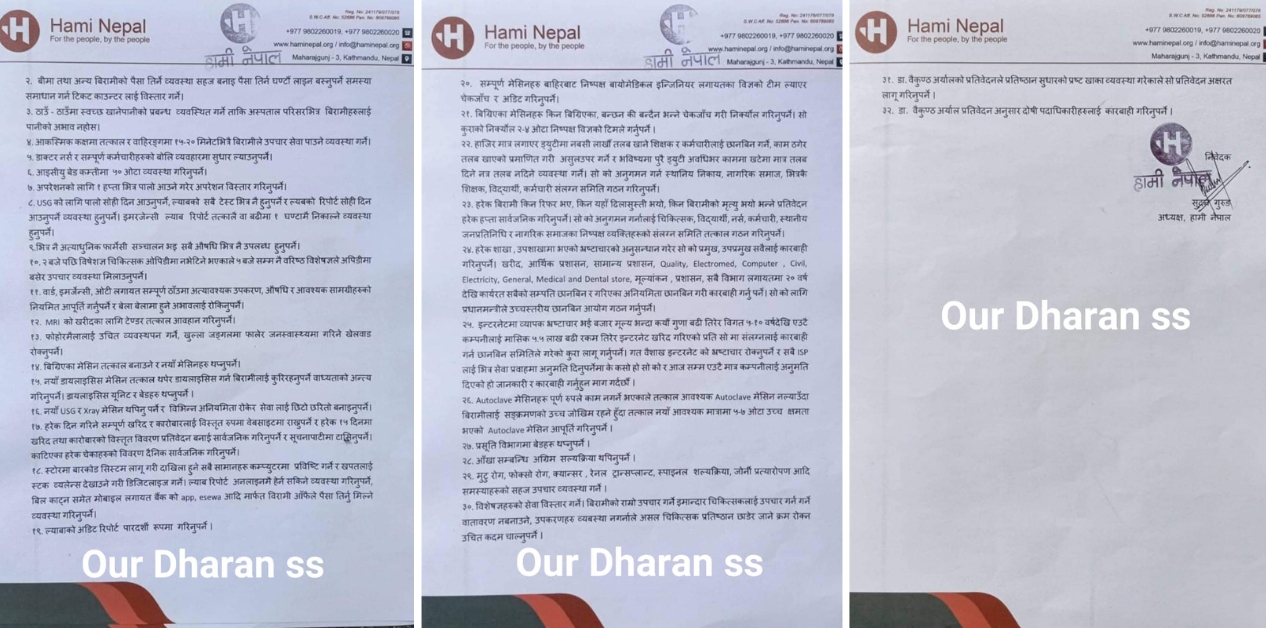
The 32-point list of demands submitted one month after the start of the movement.
On July 15, 2021, the then-Prime Minister Deuba had formed a Problem Identification and Investigation Task Force on B.P. Institute. The task force, formed after a long protest by doctors and staff, submitted its report on August 2, 2021, recommending legal action against Vice-Chancellor Giri for failing to provide proof of the ‘Professor’ title he used and for issues like coming to the office after consuming alcohol. The majority of the demands raised by the ‘Hami Nepal’ group were based on that very report.
Local to central-level leaders of the Nepali Congress were among those who wanted to remove Vice-Chancellor Giri, who had been appointed by the CPN (UML) government. At a time when Giri was repeatedly embroiled in controversy and the task force formed by Deuba had also recommended action against him, Sudan’s team arrived in Dharan, making the issues raised by that same report their demands.
Sampang, who had just won the election, had a different momentum then. He had many supporters. When he publicly began to criticize Sudan, his supporters stopped participating in the movement.
The local level election concluded amidst the movement. However, there was no end in sight for the protest. About two months after the start of the movement, on May 30, 2022, an agreement was reached between the protesters and the Institute to form a task force to discuss and address the 32 demands raised by the protesters. This task force included five representatives from the Institute, five from the protesters, and one from the Dharan Sub-Metropolitan City.
The task force met for six consecutive days and submitted a report with recommendations and suggestions on June 5. However, Vice-Chancellor Giri did not implement the report. After that, the movement was further prolonged. Young people from Sikkim and Darjeeling also participated in the movement. Videos of them addressing the crowd, urging Dharan residents to ‘wake up’ and identifying themselves, can still be found on social media. Padam Tamang from Sikkim gave a speech at the protest site, asking Dharan residents to join the movement because someone’s life was being played with at the B.P. Institute. He said, ‘If I can come from Sikkim and speak, why don’t you people speak?’
However, as the movement dragged on, internal divisions grew among the protesters. The number of participants in the demonstrations began to decline.
Dharan residents and people in countries like Hong Kong and the UK used to send financial and material support to Sudan’s group, which was leading the movement from Dharan. However, participants in the movement themselves expressed dissatisfaction, claiming that the amount collected and how it was spent lacked transparency. Devlal Shrestha, who was involved in the movement at that time, says, “Locals provided water, food, and financial help. Many people also sent money from Hong Kong and the UK. We did not check the accounts; it must have been spent on the movement.”
Harka Sampang, who had repeatedly used the same platform for campaigning before the local elections, had by then become the Mayor of Dharan. The protesters reminded Mayor Sampang of his earlier promises and urged him to participate in the protest program. But Sampang refused to go. Instead, he started verbally attacking them, accusing them of coming from outside to protest in Dharan. Sudan and Harka engaged in mutual accusations and verbal abuse. During this period, Sampang even accused Sudan of being an ‘Indian citizen.’ On July 2, 2022, Sampang wrote on social media that the movement was going off-track and posed a danger of shifting the focus elsewhere instead of hospital reform. He stated that he no longer supported the movement. Following the accusation regarding his nationality, Sudhan countered by displaying a photocopy of his citizenship certificate at the protest program.
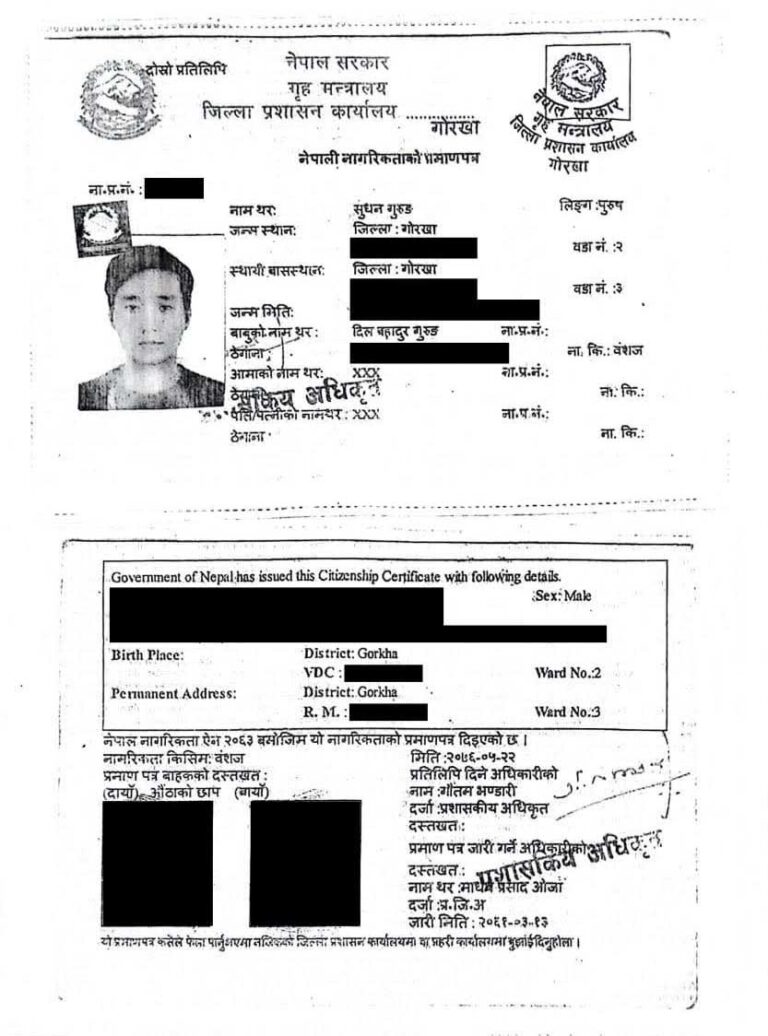
Photocopy of Sudan’s citizenship certificate
Sampang, who had just won the election, had a different momentum then. He had many supporters. When he publicly began to criticize Sudan, his supporters stopped participating in the movement.
After about five months of continuous demonstration, the then Federal Health Minister Bhawani Prasad Khapung came to Dharan, held talks with the protesters, and reached an agreement. A five-point agreement was reached on August 21, 2022, between Minister Khapung, Sudan representing the protesters, and Institute Vice-Chancellor Giri. The points were merely routine issues: installing a digital X-ray machine, calling for a tender to purchase an MRI machine, making the procurement process transparent, making the doctor selection process transparent, streamlining management, and ensuring regular monitoring of the hospital by relevant authorities. The issue of ending the anomalies they had been raising from the start was nowhere in the agreement document.
The five-point agreement reached on August 21,2022, between then-Health Minister Bhawani Prasad Khapung and the protesters.
However, the agreement they reached after a five-month-long movement has not been implemented to date. Even now, the situation remains the same where patients have to go to Biratnagar due to the lack of an MRI machine. Mahesh Shrestha, who left the movement midway, says, “The person who raised the issue of transparency in the movement was himself not transparent about financial or other matters. Seeing his access to big leaders and his lifestyle, it could be understood that he was not acting on his own will but was being used by someone else.”
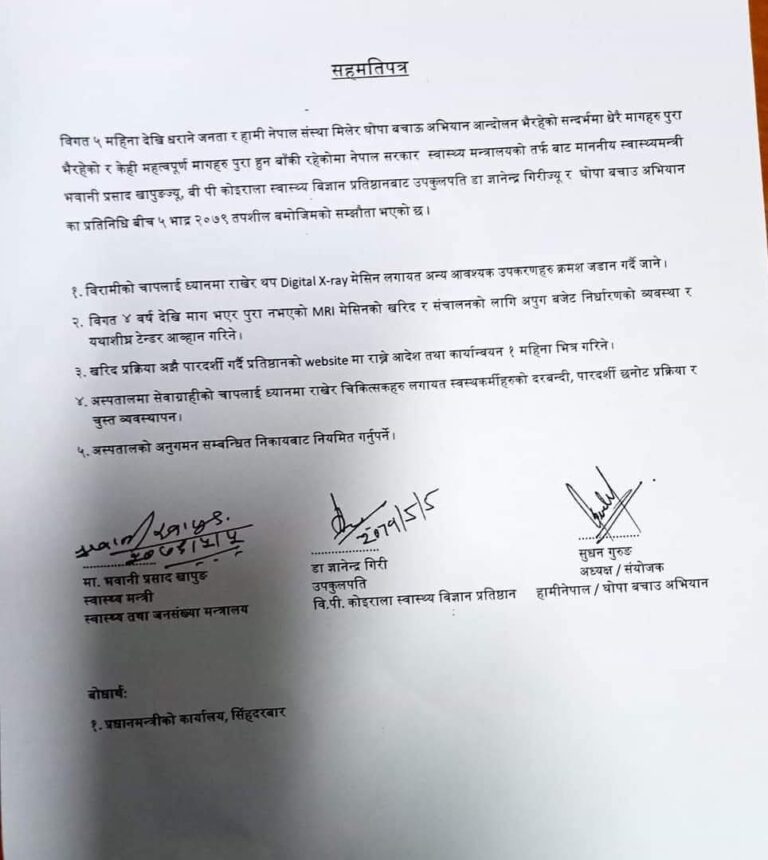
Conclusion of the movement in the presence of Minister Bhawani Prasad Khapung. Photo: Hami Nepal
First DJ, then activist
Sudan’s connection with Dharan and Dhankuta is old. According to the citizenship certificate he made public during the movement, he is the son of Dil Bahadur Gurung of Chumnubri Rural Municipality-3, Gorkha. Dil Bahadur’s second wife, Gyanu Lama Tamang, is Sudan’s mother.
A video of Gyanu, who identifies herself as ‘Jwaladevi Chandi Mata’ from Bouddha, Kathmandu, crying in the field because she couldn’t find a proposer and seconder when she went to the Rastriya Sabha Griha to register her candidacy for the 2017 House of Representatives election, was made public in the media. She also ran as an independent candidate for Kathmandu Metropolitan City in the local level election. Those who know Gyanu well say that she participates in royalist programs and runs for office in every election.
Sudan, who had an old acquaintance with Balen (current Mayor of Kathmandu Balendra Shah) from his time in the music industry, overnight advanced with the same agenda as Balen’s, from negotiating with the Nepal Army to making Sushila Karki Prime Minister and dissolving the Parliament.
Sudan, born in Kathmandu, went to live with relatives in Dhankuta when he was young. He studied at Bal Sansar School in Dhankuta for a few years. Bishnu Shrestha, former president of the Bhedetar Hotel Association, is a relative of Sudan on his maternal grandmother’s side. Bishnu says Sudan stayed at his house in Dhankuta and studied at Bal Sansar for a few years. Nabin Raut, the operator of Bal Sansar, also confirmed that Sudan studied there when he was young. He says, “Many people who studied with Sudan are still in Dhankuta.”
His mother, Gyanu, used to bring Sudan to relatives’ houses in Dharan from a young age. Rupam Lama and Anup Lama of Dharan were Gyanu’s relatives.
After Dhankuta, he went to Chitwan and studied there. Then he went to Kathmandu. He started enjoying the entertainment world of clubs and hotels in Kathmandu.
Around 2006, large dance parties were organized in Dharan. Sudan, with his long hair, started coming to Dharan as a DJ (Disk Jockey) to play music at these dance parties. Once, he held a dance party at the Swimming Pool in Dharan-15, which also included a fashion show. The choreography for the fashion show was done by Dharan’s model Bhagawati Limbu. After that, Sudan organized a mask dance party in the open ground of the then-Nirvana Country Club and Golf Resort within the B.P. Institute of Health Sciences. His company, named ‘OMG,’ used to organize such events. Lalit Rai, an old DJ from Dharan, recalls that Sudan organized two or three parties in Dharan. He says, “The acquaintance established during the dance parties made it easy for him to launch the movement later.”
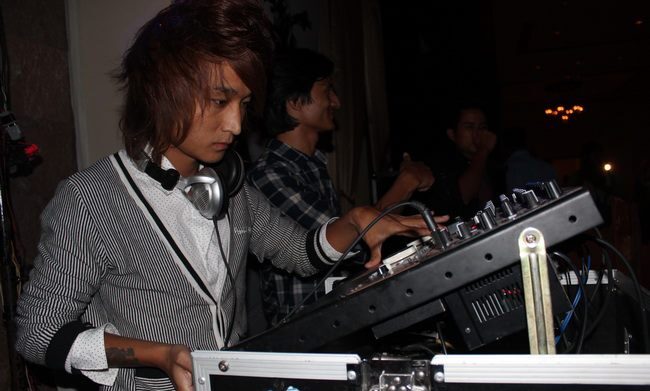
Sudan when he was a DJ. Photo: Sudan’s Facebook
DJ Sudan, who used to play music for party-goers in Kathmandu hotels as well, left this profession after the hotel business came to a halt following the 2015 earthquake. He became active in distributing relief to earthquake victims. After that, he formed the ‘Hami Nepal’ organization and got involved in social work, eventually coming to Dharan to launch the movement, utilizing the connections he had made as a DJ.
He came to Dharan and sought help from Mahesh Shrestha ‘Bikky’, former president of the Hotel Association of Dharan and operator of Hangkuk Sarang Korean Restaurant, to gather people for the movement. Bikky introduced him to local social organization members and journalists. Shrestha says, “Since we were old acquaintances, I provided the sound system and introduced him to people for the movement.”
During this process, a group including Mahesh Shrestha, President of the Newar Unity Society, and Nishchal Mohan Palikhe, President of the social organization Hope Dharan, supported Sudan. He formed the ‘Ghopa Bachau Abhiyan’ group, including local youths Sristi Shrestha, Spain Magar, and others. The current B.P. Institute was formerly a British Gurkha recruitment center, known as Ghopa Camp. Even now, older locals still refer to B.P. as Ghopa Camp. The campaign was started using that old name.
Just like in the Ghopa Bachau movement, Sudan’s fame and controversy are equally prominent in the Gen Z movement. Sudan, who introduced himself only as a volunteer assisting in the management of the movement on the first day of the Gen Z movement, September 8, suddenly gained fame as a Gen Z leader the next day, September 9.
Sudan, who had an old acquaintance with Balen (current Mayor of Kathmandu Balendra Shah) from his time in the music industry, overnight advanced with the same agenda as Balen’s, from negotiating with the Nepal Army to making Sushila Karki Prime Minister and dissolving the Parliament.
Harka, who had portrayed Sudan as an Indian agent in Dharan, reached Kathmandu with supporters, demanding that he be made the Prime Minister. Once there, Harka and his supporters did not hold back from verbally attacking Sudan. There was even a physical altercation between Harka’s and Balen’s supporters.
It is currently impossible to say where the developments following the Gen Z movement will lead Sudan, who was unsuccessful after five months of street protests in Dharan. Nishchal Mohan Palikhe, President of Hope Dharan, who actively participated in the Ghopa Bachau Abhiyan, expresses concern upon witnessing the recent controversies surrounding Sudan, with whom he once protested.
He says, “I know Sudan as a social activist, but seeing his working style and controversies now compared to before, I have doubts; is he not being used as someone’s tool?”